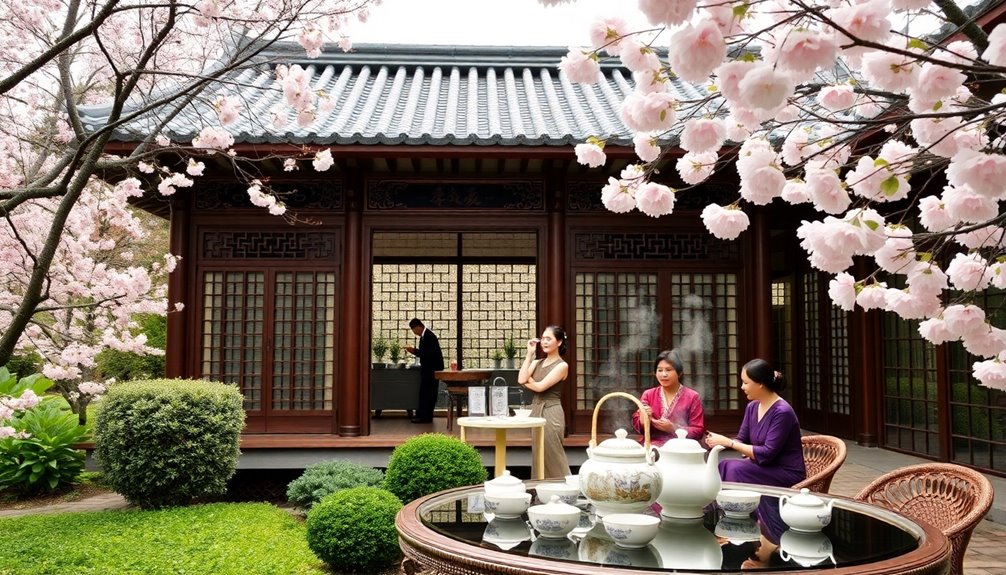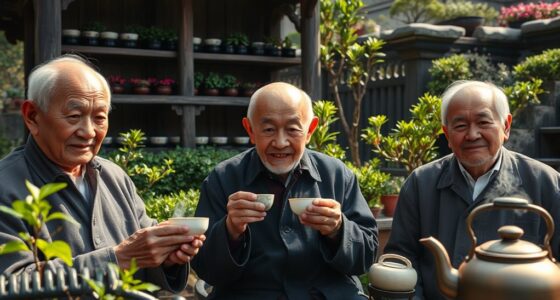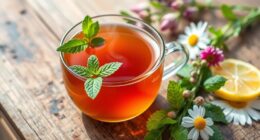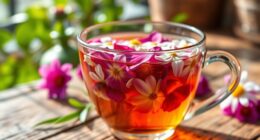Pu-erh tea is China's most prized brew because of its rich history and unique fermentation process. Originating in Yunnan Province, this tea matures over time, developing complex flavors that delight your senses. Both types, raw (sheng) and ripe (shou), offer distinct characteristics that further enhance your tasting experience. It's deeply woven into ancient tea ceremonies and symbolizes hospitality and respect. Plus, its aging process adds layers of flavor, making each brew special. If you're curious about its cultural roots and the secrets behind sourcing quality pu-erh, there's so much more to uncover.
Key Takeaways
- Pu-erh tea's unique fermentation process creates complex flavors that develop and mature over time, enhancing its desirability.
- Aged pu-erh tea is considered a valuable commodity, with some vintage varieties fetching prices exceeding $150,000.
- Integral to Chinese cultural traditions, pu-erh tea symbolizes hospitality, respect, and is used in significant rituals like weddings.
- Documented health benefits, such as cholesterol-lowering effects, contribute to pu-erh tea's esteemed status in traditional Chinese medicine.
- The aging process allows for unique tasting experiences, inviting deeper appreciation among tea enthusiasts and collectors.
Introduction

Pu-erh tea's rich history and unique fermentation process make it a fascinating beverage to explore. Originating in Yunnan Province during the Eastern Han Dynasty, this tea has a deep cultural significance in China. With trade dating back to the Tang Dynasty, Pu-erh tea has evolved into a treasured item among tea drinkers.
The fermentation process sets it apart from other teas, creating complex flavors that develop further as the tea ages.
You'll find two main types of Pu-erh tea: raw (sheng) and ripe (shou). Raw Pu-erh undergoes natural fermentation, resulting in a fresh, vibrant taste, while ripe Pu-erh is quickly fermented, offering a smoother, earthier profile. Each type provides a unique tasting experience, appealing to various preferences among tea enthusiasts.
The market for aged Pu-erh tea has grown remarkably, with high-quality varieties fetching prices comparable to fine wines and art. This trend not only highlights its value as a prized commodity but also emphasizes its role in traditional Chinese medicine and rituals.
Ancient Chinese Tea Traditions

Tea has played a pivotal role in shaping ancient Chinese traditions, particularly through its various ceremonies and customs. Pu-erh tea, originating from Yunnan Province during the Eastern Han Dynasty, has become a cornerstone of Chinese culture. Its journey along the Tea Horse Roads highlights its significance in trade, as its durability made it a favored commodity among merchants.
Incorporating Pu-erh tea into traditional Chinese medicine, ancient texts like Shen Nongs Herbal Classic document its health benefits, including cholesterol-lowering effects. This rich history underscores the tea's importance beyond mere enjoyment.
Tea drinking rituals are deeply woven into the fabric of Chinese hospitality, reflecting values of frugality and benevolence. Whether during ceremonies, as betrothal gifts, or in religious practices, Pu-erh tea symbolizes respect and goodwill.
Moreover, the ethnic minorities in Yunnan hold a significant cultural reverence for the ancient trees from which this tea is harvested. These trees aren't just sources of tea; they represent a connection to the land and the heritage of the people.
Through these traditions, you can see how Pu-erh tea embodies the essence of Chinese culture and community.
Aged for Optimal Flavor

Aged pu-erh tea offers a remarkable journey of flavor that evolves with time. The fermentation process enhances its flavor complexity, resulting in rich, mellow notes of dark fruits and earthiness as the tea matures.
During the aging process, each brew from the same tea cake will taste different, revealing a unique profile that intrigues your palate.
High-quality pu-erh can be aged for decades, and some vintage varieties are so rare that they fetch prices upwards of $150,000. This rarity elevates aged pu-erh to a collectible item, much like fine wines, where both age and provenance significantly influence market value.
The changing flavor characteristics make re-steeping aged pu-erh a captivating experience. Each infusion allows you to explore a multiplicity of tastes from a single tea cake, showcasing its evolving nature.
Whether you're a seasoned tea enthusiast or a curious newcomer, the depth and richness of aged pu-erh invite you to savor each sip, celebrating the art of time in your cup.
Embrace this extraordinary tea and let its flavors unfold, revealing the intricate tapestry crafted over years of patient aging.
Cultural Significance in Ceremonies

The rich tapestry of flavors found in aged pu-erh tea extends beyond the cup, intertwining with deep cultural significance in various ceremonies. In Chinese culture, serving pu-erh tea during weddings symbolizes prosperity and longevity, making it a vital part of significant life events.
As you engage in traditional tea ceremonies, you'll notice how the brewing and sharing of this tea fosters connections, reflecting the values of hospitality and community.
For the indigenous peoples of Yunnan, pu-erh tea trees hold sacred status, featuring prominently in religious rituals that highlight their cultural importance.
When you offer pu-erh tea as a gift during important occasions, you reinforce social bonds and demonstrate respect for the recipient, deepening your connections.
Moreover, the ritual of repeatedly brewing pu-erh tea during gatherings enhances storytelling and shared experiences, inviting everyone to partake in the rich narratives that accompany each sip.
This practice not only elevates your appreciation for the tea but also strengthens the communal ties that bind you to others.
In every ceremony, pu-erh tea becomes more than just a beverage; it transforms into a symbol of unity, tradition, and shared heritage.
Quality Control Issues

When exploring the world of pu-erh tea, you might encounter a troubling issue: quality control. The rise of counterfeit products has made it increasingly difficult to ensure you're buying authentic pu-erh teas. This market is rife with buyer deception, especially following the price boom from 1999 to 2007, which created a market bubble. During this period, many lower-quality teas were misrepresented as high-quality maocha, complicating your purchasing decisions.
To navigate these quality control issues, you need to prioritize sourcing from reputable vendors. Trust is crucial, considering the complex supply chain in the pu-erh market, where multiple middlemen can obscure traceability. Without knowing the tea's origin, you could easily fall victim to scams.
Familiarizing yourself with notable tea names, regions, and market trends is essential for avoiding overpriced or fake products. By being vigilant and informed, you can ensure that your investment in pu-erh tea is worthwhile.
Practical Applications

Many enthusiasts find that pu-erh tea offers a versatile experience, allowing you to enjoy it in various forms, such as young raw (Sheng) and ripe (Shou). Each type presents distinct flavor profiles, ranging from fresh and grassy to rich and earthy, which you can explore through the brewing process.
By steeping pu-erh multiple times—typically for 15 to 60 seconds—you enhance its complexity and personalize your tasting experience.
Beyond its delightful flavors, aged pu-erh tea also boasts impressive investment value, with rare varieties often seen as collectibles, fetching prices that rival fine wines and art. The unique microbial fermentation process not only alters the tea's flavor over time but also contributes to its potential health benefits, such as improved digestion and metabolic health.
When you're ready to dive into the world of pu-erh, be sure to choose reputable vendors like Yunnan Sourcing or Crimson Lotus. They offer quality selections that cater to both newcomers and seasoned enthusiasts, ensuring you receive authentic products that enhance your tea journey.
With pu-erh tea, you're not just sipping a beverage; you're investing in an experience.
Conclusion
In conclusion, pu-erh tea isn't just a drink; it's a journey through China's rich culture and history. As you savor its unique flavors, remember the care that goes into aging each batch for optimal taste. While quality control can be a challenge, the rewards are worth it. So, whether you're enjoying it in a traditional ceremony or simply at home, pu-erh tea invites you to experience a cherished part of Chinese heritage.










